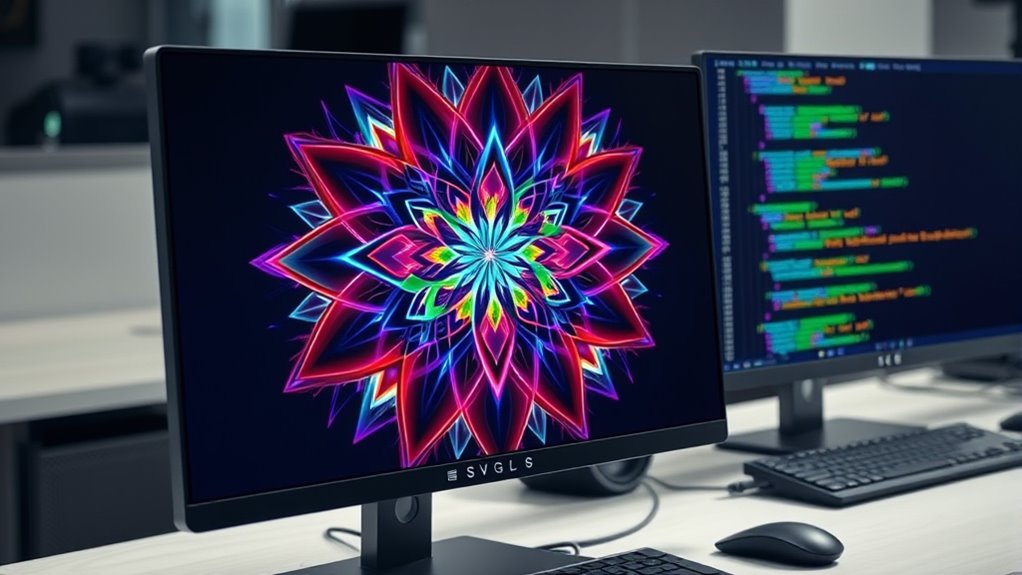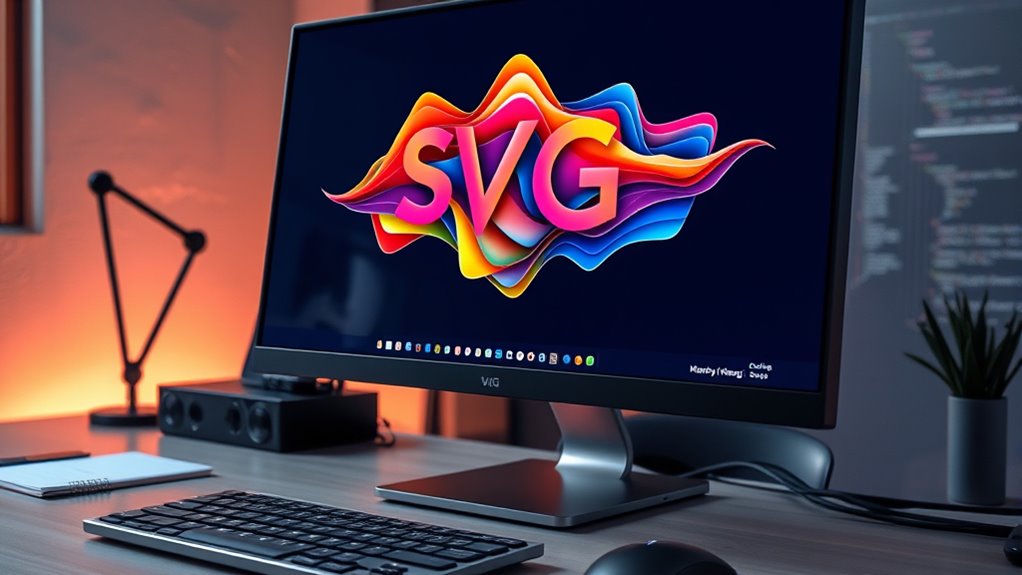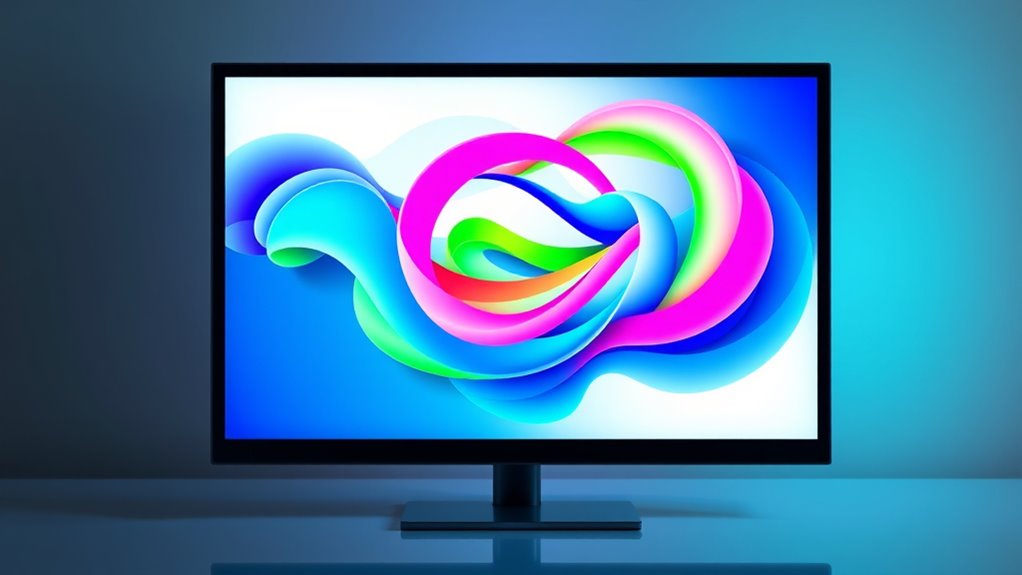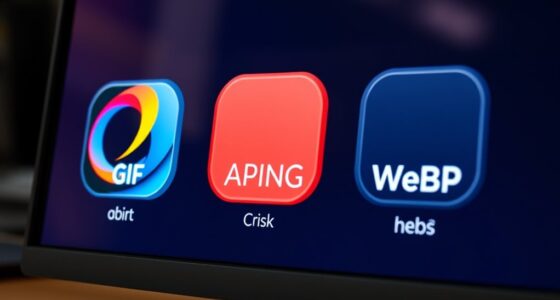Scalable Vector Graphics (SVG) are XML-based images that stay sharp at any size, making them perfect for responsive design. You can easily customize them with colors, shapes, and animations to fit your project. SVGs are lightweight, load fast, and work well across devices and screens. They’re simple to edit with design software or code. If you want to explore how they can boost your digital work, there’s more to discover ahead.
Key Takeaways
- SVGs are vector-based images created with XML code, supporting infinite scalability without quality loss.
- They enable responsive design, animation, accessibility, and easy customization for digital graphics.
- SVG files use tags like `
- They are lightweight, adaptable, and ideal for icons, illustrations, and complex graphics across devices.
- Emerging technologies like AI and AR/VR are enhancing SVG capabilities for interactive and immersive experiences.
What Are SVGs and How Do They Work

Ever wondered what makes SVGs so popular in web design? SVGs, or Scalable Vector Graphics, are vector-based images that use XML code to define shapes, colors, and lines. Unlike raster images, SVGs can scale infinitely without losing quality, making them perfect for responsive design. You can animate SVGs to create engaging effects through SVG animation, adding motion to your graphics seamlessly. Additionally, SVGs support accessibility features, ensuring screen readers and assistive technologies can interpret the content accurately. This means your visuals aren’t just beautiful—they’re also inclusive. Understanding how SVGs work involves grasping their underlying digital design principles, which helps in creating sharp, interactive, and accessible graphics that enhance user experience across all devices. Recognizing the importance of contrast ratio helps optimize your SVG graphics for various viewing conditions, ensuring clarity and impact. Incorporating color contrast guidelines further improves the visual accessibility of your graphics, especially for users with visual impairments. A solid understanding of responsive design techniques also ensures your SVGs look great on any screen size or resolution. Moreover, knowing how to leverage vector graphics capabilities enhances the flexibility and scalability of your visuals across different platforms.
Advantages of Using SVGs Over Raster Images

SVGs let you resize images without losing quality, so your designs stay sharp at any size. They also have smaller file sizes compared to raster images, which helps your website load faster. Plus, SVGs are easy to edit and customize, giving you more control over your visuals.
Scalability Without Loss Quality
Unlike raster images, SVGs can be scaled to any size without losing clarity, making them perfect for responsive design and high-resolution displays. This scalability guarantees your vector patterns stay sharp, whether on a small mobile screen or a large monitor. You can easily resize SVGs without worrying about pixelation, unlike raster images. Additionally, SVGs support animation techniques that remain smooth at any size, enhancing your designs’ interactivity. This quality allows you to create versatile graphics that adapt seamlessly across devices. Because SVGs are resolution-independent, your visuals maintain their crispness and professional appearance regardless of scaling. Their versatility makes SVGs suitable for icons, illustrations, or complex graphics, providing unmatched flexibility and visual consistency.
Smaller File Sizes
Have you noticed that SVG files often have smaller sizes compared to raster images? This is thanks to SVG compression techniques, which optimize the vector data without sacrificing quality. Unlike raster images that store pixel information, SVGs use code to describe shapes and colors, resulting in more efficient file size reduction. When you save or export an SVG, it typically involves compressing the data, making files easier to store and share. This smaller file size not only speeds up website loading times but also reduces bandwidth consumption. By leveraging SVG compression, you assure your graphics remain sharp across devices while keeping your files lightweight. Additionally, understanding regional legal resources can help in effectively managing technical projects across different markets. Overall, SVGs offer a practical advantage for web development and digital design through their ability to maintain quality with minimal file size.
Easy Editing and Customization
Because SVG files are based on code rather than pixel data, they’re inherently easy to edit and customize. You can quickly change colors to match your design preferences or branding by adjusting simple attributes or CSS styles. This makes color customization straightforward, even for complex graphics. Additionally, SVGs support layer management, allowing you to organize different elements into separate layers. You can easily hide, lock, or reorder these layers to streamline your editing process. Unlike raster images, which require complex editing tools for adjustments, SVGs let you modify individual components directly within the code or design software. This flexibility enables rapid iterations, personalized tweaks, and precise control, making SVGs an ideal choice for dynamic and adaptable visuals. Furthermore, understanding the lifestyle of designers and developers can help optimize your workflow when working with SVGs, especially when incorporating vibrational principles to enhance creativity and productivity. Recognizing the latest design trends can also inspire innovative uses of SVGs to stay current in a competitive market. Being aware of the impact of SVGs on website performance can help you make more informed decisions to improve user experience and load times.
Key Components and Syntax of SVG Files

Understanding the key components and syntax of SVG files is essential for creating and editing scalable vector graphics effectively. SVG files are XML-based, meaning they use tags to define shapes, lines, and colors. Key elements include `
Creating and Editing SVGs: Tools and Techniques

You can create and edit SVGs using various design software options or by manually coding your files. To guarantee clean and efficient designs, follow best practices and stay organized while editing. Mastering these tools and techniques helps you produce precise, scalable graphics with ease. Additionally, understanding Best Modern Toilet features can inspire innovative design elements in your graphics projects, ensuring your visuals align with current trends and functionalities. Utilizing AI-powered design tools can further optimize your workflow and enhance creative possibilities.
Design Software Options
Choosing the right software is essential for creating and editing SVGs effectively. Whether you’re designing detailed vector illustrations or crafting simple icons, the tools you choose can streamline your workflow. Popular options include Adobe Illustrator, Inkscape, and Figma, each offering unique features for icon design and vector art. Here’s a quick overview:
| Software | Best For | Cost |
|---|---|---|
| Adobe Illustrator | Professional vector illustrations | Subscription |
| Inkscape | Free, open-source SVG editing | Free |
| Figma | Collaborative icon design | Freemium |
| Vectr | Beginner-friendly vector work | Free |
| Sketch | Mac-focused UI and icon design | Paid |
Select software that matches your skill level and project needs for ideal results. Additionally, consider the remote hackathons that often involve designing creative SVG assets for diverse projects and teams. When working with SVGs, understanding vector graphics and their scalability can greatly enhance your design process, especially when creating natural materials inspired illustrations that align with sustainable design principles. Exploring the capabilities of these tools can also help you incorporate scalable vector graphics into various digital projects more effectively. Furthermore, awareness of ongoing AI security vulnerabilities can inform how you protect and manage your digital assets during the design process.
Manual Coding Tips
Are you ready to take full control of your SVG creations? Manual coding gives you the power to fine-tune every detail. Use color gradients to add depth and vibrancy directly within your code, customizing transitions seamlessly. When editing, focus on path manipulation; adjusting the ‘d’ attribute allows precise shaping of your graphics. Take advantage of tools like a text editor or SVG-specific editors to write clean, efficient code. Experiment with layering multiple gradients or combining shapes for complex visuals. Remember, small adjustments in code can considerably impact your design’s look and feel. Additionally, understanding the different cookie categories helps you manage your privacy preferences while working on your SVG projects. By mastering these techniques, you’ll create scalable, dynamic SVGs that are both lightweight and highly customizable. Empowering Seniors With Personalized In-Home Care demonstrates how tailored solutions can significantly enhance quality of life. Manual coding empowers you to craft exactly what you envision, with maximum control over every element. Incorporating mindfulness techniques into your workflow can also help maintain focus and reduce errors during complex editing tasks. Being aware of storage conditions can ensure your SVG files remain in optimal condition over time. Furthermore, adhering to a financial settlement time limit can streamline your project management process and prevent delays.
Editing Best Practices
What are the best tools and techniques to efficiently create and edit SVGs? To streamline your workflow, use vector graphic editors like Adobe Illustrator, Inkscape, or Figma, which offer precise control over shapes, colors, and layers. Focus on color management by choosing consistent color palettes and avoiding unnecessary gradients to ensure clarity across devices. When editing, consider accessibility considerations—use descriptive titles, labels, and ensure sufficient contrast for viewers with visual impairments. Keep your SVG code clean by removing redundant elements and using semantic markup. Regularly preview your SVGs on different screens to verify color consistency and accessibility. Additionally, understanding emotional support principles can help you stay motivated and manage stress during complex editing projects. These best practices help you produce scalable, inclusive graphics that are easy to update and maintain.
Embedding SVGs in Web Pages

Embedding SVGs in web pages allows you to integrate scalable graphics directly into your HTML, providing crisp visuals across all screen sizes. You can embed SVGs using various techniques, such as inline embedding, linking via the `` tag, or using CSS backgrounds. Each method impacts SVG accessibility differently; for example, inline SVGs enable better control over accessibility features like ARIA labels and focus states. When embedding, consider which technique best suits your needs for styling and interaction. Properly implemented, SVG accessibility ensures all users can interpret your graphics, regardless of assistive technologies. Keep in mind that choosing the right embedding technique improves your webpage’s performance and maintainability while guarantees your SVGs are accessible and visually consistent across devices.
Optimizing SVGs for Performance and Compatibility

To guarantee your SVGs perform well across devices and browsers, you need to optimize them for both size and compatibility. Start by applying compression techniques like removing unnecessary metadata, whitespace, and comments, which can notably reduce file size. Use tools such as SVGO or SVGOMG to automate this process. Ensuring accessibility considerations are met is also essential; include descriptive titles, ARIA labels, and ensure sufficient color contrast to make your SVGs usable for all users. Test your graphics across different browsers and devices to identify and fix compatibility issues. Additionally, consider embedding SVGs inline for faster rendering or linking to optimized external files. Proper optimization not only enhances performance but also broadens accessibility, making your SVGs more effective and inclusive.
Future Trends and Innovations in SVG Technology

As SVG technology continues to evolve, innovative tools and standards are shaping its future capabilities. AI integration is playing a significant role, enabling smarter, more dynamic graphics that adapt to user interactions and data inputs. You’ll see AI-powered tools automating design processes, optimizing SVGs for better performance, and enhancing accessibility. Additionally, immersive experiences are becoming more common, with SVGs supporting augmented reality (AR) and virtual reality (VR) applications. This trend allows you to create interactive, 3D-like visuals that engage users more deeply. As these innovations develop, SVGs will become even more versatile, blending seamlessly with emerging technologies to deliver richer, more responsive digital experiences. Expect future SVGs to be smarter, more immersive, and highly integrated with AI-driven tools.
Frequently Asked Questions
Can SVGS Be Animated for Interactive Web Experiences?
Yes, SVGs can be animated for interactive web experiences. You can use SVG animation techniques like CSS animations, SMIL, or JavaScript to bring your graphics to life. These methods allow you to create interactive SVG elements that respond to user actions, like clicks or hovers. By combining animation techniques with interactive SVG elements, you can craft engaging, dynamic visuals that enhance your website’s user experience.
How Do SVG Filters Enhance Visual Effects?
SVG filters enhance visual effects by allowing you to add color adjustments and drop shadows, making your graphics more dynamic and engaging. You can apply filters to create blurring, color shifting, or shadow effects that add depth and emphasis. With these filters, you control how elements appear, making your designs more visually appealing. They’re a powerful tool to customize and elevate your SVG graphics effortlessly.
Are SVGS Suitable for Complex Illustrations or Only Simple Graphics?
You might wonder if SVGs suit complex illustrations or just simple graphics. SVGs handle intricate vector detail well, making them suitable for complex illustrations that require precision and scalability. Their ability to maintain quality at any size makes them ideal for detailed artwork. However, very complex or highly detailed images can increase file size and rendering time. Overall, SVGs are versatile enough for both simple and complex vector-based illustrations.
What Accessibility Considerations Are Important for SVG Content?
When considering accessibility for SVG content, you should focus on ensuring good color contrast so all users can distinguish elements easily. Make sure your SVGs are keyboard navigable by providing focus states and ARIA labels. Avoid relying solely on color to convey information, and test with assistive technologies. This way, users with visual impairments or mobility challenges can access and understand your SVG graphics effectively.
How Does Browser Support Vary for Advanced SVG Features?
Did you know over 80% of browsers support most advanced SVG features? Browser compatibility varies considerably, affecting how you implement complex SVG elements. Some features like filters and animations are well-supported in Chrome, Edge, and Safari, but may have limited or no support in older versions of Firefox or Internet Explorer. Always check feature support tables to ensure your SVGs render correctly across different browsers and devices.
Conclusion
Now that you understand SVGs, you see their power to bring clarity and flexibility to your designs. While raster images fade with scaling, SVGs preserve sharpness and responsiveness, ensuring your visuals remain impactful. Embrace this technology not just for its versatility, but for the creative freedom it offers. In a world of fleeting pixels, SVGs stand firm, empowering you to craft timeless, scalable graphics that truly resonate.









